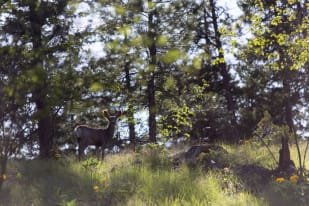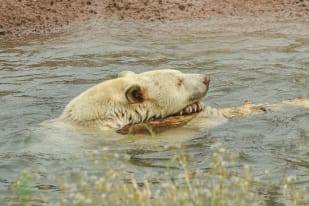Embracing Wildlife Responsibly in Kamloops
Kamloops offers a rare opportunity to observe a wide range of wildlife across grasslands, wetlands, and city parks. This article outlines how to safely and respectfully observe wildlife in Kamloops, focusing on practices that protect both people and animals while enhancing the experience for everyone involved.
The region's variety of habitats supports animals such as black bears, mule deer, bighorn sheep, and hundreds of bird species. Preserving this biodiversity depends on following clear practices that prioritize safety, respect, and conservation.
Top Wildlife Viewing Locations in Kamloops
BC Wildlife Park
BC Wildlife Park plays an important role in education and conservation, housing close to 200 animals across 65 species. Visitors can see local animals up close, including black bears like Tuk, Nuumes, Hamilton, and Clover the Spirit Bear, the only Kermode bear under human care.
Beyond wildlife viewing, the park offers interactive programs such as feed talks, Birds of Prey demonstrations, and the Nature Exchange, all designed to promote a deeper understanding of conservation and ethical wildlife interaction.
Lac du Bois Grasslands Protected Area
Lac du Bois Grasslands protects an important stretch of grassland and forest, home to species like mule deer, bighorn sheep, and a wide range of birds. Staying on marked trails is crucial to preserving this fragile ecosystem.
The park's hiking routes naturally lead to wildlife encounters, and the absence of paved trails helps minimize human impact. Moving quietly and staying alert improves the chances of observing animals without causing them stress.
Tranquille Wildlife Management Area
Located near Kamloops Airport, the Tranquille Wildlife Management Area provides essential wetland habitat for waterfowl and many other bird species. It becomes especially active during spring and summer migrations.
Early morning and late afternoon are the best times to experience the area's birdlife. Using binoculars and natural cover, visitors can enjoy observing birds while minimizing disturbance.
Urban Wildlife in Kamloops
Kamloops residents often encounter black bears, mule deer, and a wide range of birds within city limits, particularly in parks and neighbourhoods near natural areas. The city’s Bear Smart Community designation highlights its commitment to reducing human-wildlife conflict.
Proper waste management, responsible pet supervision, and respect for wildlife corridors are part of everyday life in Kamloops. When encountering wildlife, maintaining distance and avoiding feeding are critical actions that help keep both people and animals safe.
Essential Safety Tips for Wildlife Observation
General Guidelines
Observing wildlife safely requires maintaining a respectful distance, using tools like binoculars or zoom lenses to avoid influencing animal behaviour. Staying on designated trails helps protect both the environment and the animals that live there.
Feeding wildlife disrupts natural behaviours and can lead to dangerous situations. Ethical observation protects the survival skills that animals need and ensures the safety of future visitors.
Bear Safety Measures
Signs of bear activity, such as tracks, scat, or claw marks, should alert visitors to be cautious. Making noise while hiking through dense areas helps prevent surprising a bear, and carrying bear spray can provide a critical safety measure if needed.
Proper storage of food and scented items is essential. Using bear-proof containers and packing out all waste helps prevent bears from associating humans with easy meals, reducing the likelihood of dangerous encounters.
Snake Awareness
The Northern Pacific Rattlesnake, recognizable by its patterned colouring and distinctive rattle, inhabits parts of Kamloops. Observers must avoid reaching into rocky crevices, tall grass, or under logs where snakes may be hiding.
If a rattlesnake is encountered, backing away slowly without sudden movements gives the snake space to retreat. Recognizing snake behaviour and remaining calm reduces the risk of bites.
Birdwatching Etiquette
Successful birdwatching involves moving quietly and speaking softly to minimize stress on birds. Excessive noise or sudden movements can cause birds to flee, interrupting essential activities like feeding and breeding.
Respecting nesting areas is vital. Approaching nests can cause parent birds to abandon their young, so observers should stay back and use binoculars to appreciate bird behaviour without interference.
Conservation and Community Engagement
WildSafeBC Initiatives
WildSafeBC plays an important role in educating the public about wildlife safety. Programs like the WildSafe Ranger Program teach children the basics of coexisting with wildlife, emphasizing safety and conservation from a young age.
Workshops, signage, and public events help reinforce responsible behaviours, while collaboration with city officials ensures that consistent messages reach residents and visitors alike.
BC Wildlife Park's Conservation Role
BC Wildlife Park operates the only licensed Wildlife Rehabilitation Centre in the Kamloops area. Injured and orphaned animals receive treatment and, when possible, are released back into their natural habitats.
The park also leads the Burrowing Owl Recovery Program, releasing hundreds of captive-bred owls into the wild since 1991. This effort supports the return of a critical species to British Columbia’s grasslands, contributing to long-term ecosystem health.
Planning Your Wildlife Observation Experience
Best Times to Visit
Spring and fall offer the best wildlife viewing opportunities, coinciding with migration, mating, and active feeding periods. Early mornings and late afternoons are prime times to spot animals as they move and forage.
Summer provides visibility of young animals, while winter offers a different experience with animal tracks visible in the snow. Each season brings unique opportunities for careful observers.
Recommended Gear
Visitors should bring binoculars, a camera with a zoom lens, and field guides to help identify local species. Clothing should suit variable weather and allow for quiet movement.
Safety essentials include bear spray, a whistle, a first aid kit, and sufficient water. Being prepared for changing conditions helps ensure a safe and enjoyable experience.
Guided Tours and Educational Programs
BC Wildlife Park offers educational experiences such as animal encounters and presentations, providing deeper insight into wildlife conservation efforts. Local tour operators also offer guided hikes focused on wildlife observation and ecology.
Taking part in a guided tour increases the likelihood of wildlife sightings while providing context about animal behaviours and habitat preservation.
Fostering a Respectful Relationship with Nature
Successful wildlife observation relies on preparation, respect, and understanding. Moving quietly, staying alert, and keeping a respectful distance are key to protecting both wildlife and people.
Every responsible encounter helps support the health of Kamloops' ecosystems. By following these safe practices, visitors and residents contribute to a future where wildlife continues to thrive across the region.




